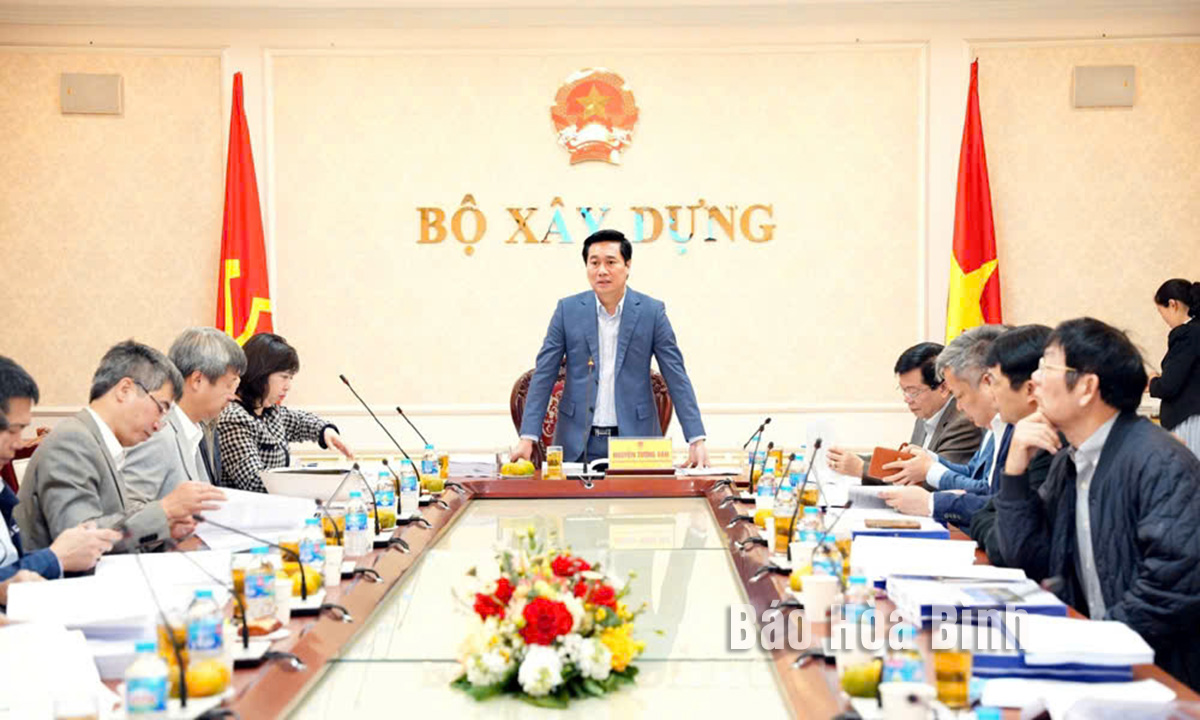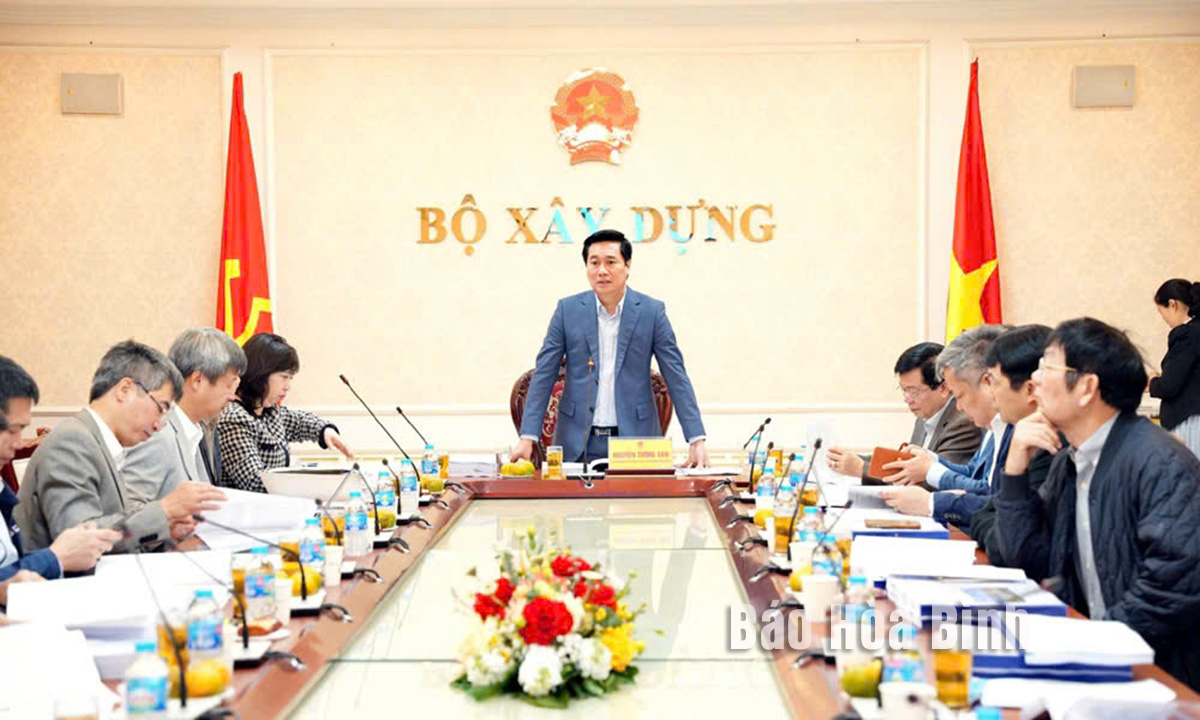
The national evaluation council on February 21 had a meeting to review the master planning for Luong Son urban area, Hoa Binh province until 2045.
Deputy Minister of Construction Nguyen Tuong
Van, Chairman of the council, chaired the meeting.
Local officials including
Nguyen Van Chuong, Vice Chairman of the provincial People's Committee; Nguyen
Duc Dung, Secretary of the Luong Son District Party Committee also attended the
meeting.
The master planning project for Luong Son is
developed in accordance with Resolution 06-NQ/TW dated January 24, 2022, by the
Politburo on the sustainable urban development of Vietnam until 2030, with a
vision towards 2045.
The planning is developed for the entire
administrative boundary area of the district with an area of approximately
36,48 ha, bordering with Hanoi’s Thach That and Quoc Oai districts in the
north; bordering with Kim Boi and Lac Thuy districts in the south; bordering
with Hanoi’s Chuong My and My Duc districts in the east; and bordering with Hoa
Binh city to the west.
Luong Son is located at the western gateway of
Hanoi, connecting to the Northwest region. It strives to become a Class-3 urban
area by 2030. It is an important hub for transportation, logistics, trade,
services, and tourism in the Northwest region. Luong Son is also one of the
socio-economic centers of the eastern area of Hoa Binh province, with main
development drivers being industry, services, tourism - resort, urban development,
and high-tech agriculture, which have strong potential to influence and promote
the development of other regions in the province.
Luong Son aims to become a green, smart,
ecological, and sustainable urban area, supporting functions in education,
health, trade, services, tourism, culture, sports, and housing not only for Hoa
Binh province but also for the western region of Hanoi. This urban area has a
strategically important position in terms of national defence and security.
Regarding the urban development model and
structure, Luong Son develops according to a multi-polar linked urban model
with three centres, five corridors, and four functional areas. Its central pole
is at Luong Son town and adjacent areas along with two poles in the central and
southern parts with their own distinct characteristics; the urban development
poles are interconnected by major urban axes and linked with external transport
corridors, connecting Hoa Binh province and the Hanoi capital region.
In terms of spatial development orientation,
Luong Son is organised based on the formation of three core centers - Northern,
Central, and Southern urban areas. The plan includes five corridors with three
multi-purposed development corridors connecting to the CT.02 expressway, National
Highway 21, and CT.39 expressway, along with two corridors serving trade
services and residential areas along National Highway 6 and the bypass of
National Highway 6. At the same time, under the planning, the Luong Son urban
area is divided into four main functional areas - central urban area, tourism
area, agricultural area, and industrial area for building material production.
According to the evaluation council, the master
planning for Luong Son until 2045 has been meticulously developed by the local
government, using systematic scientific research methods, with clear and
coherent content that meets the requirements set forth. The planning project
complies with the legal regulations on urban planning. However, further
improvements are needed.
On behalf of the provincial government, Vice
Chairman of the provincial People's Committee Nguyen Van Chuong acknowledged
the comments from the evaluation council and committed to quickly directing the
addition, revision, and completion of the project.
Concluding the meeting, Deputy Minister Nguyen
Tuong Van requested the provincial People's Committee and the consulting unit
to fully incorporate all feedback from relevant agencies to finalise the
project. The province needs to review the data, update the legal basis
thoroughly, and ensure accuracy in accordance with current regulations.
Additionally, it should supplement and reassess the data on population, labor,
the state of socio-economic infrastructure, and the region's characteristics.
Regarding planning management and projects, it is necessary to assess current
situation, review and classify projects to ensure the feasibility of the
project.
For the urban spatial orientation, it is
essential to clearly demonstrate the connection between urban characteristics
and natural elements, aligning with the goal of achieving Class-3 urban status
by 2030. In land use planning, a review of the urban development land fund is
needed, adhering to current standards and regulations, while clarifying data on
rural and urban land. Urban design should incorporate distinctive spatial
elements that reflect the regional identity. The provincial People's Committee
and the consulting unit are requested to promptly complete the planning for
submission to the Prime Minister for consideration and approval.
The Standing Board of the Hoa Binh provincial Party Committee has agreed in principle on a proposal by the Standing Board of the Party Committee of Hoa Binh city to gather feedback on the city’s 1:2000 zoning plan, which forms part of its broader urban development strategy.
Hoa Binh province has made notable progress in public administration reform and digital government development, with the satisfaction index among citizens and businesses reaching over 84%, according to recent government evaluations.
Thanks to great efforts by local authorities in recent times, the governance and public administration performance of Mai Chau district has been significantly improved.
In the afternoon of June 6, the Party Committee, the People's Council, the People's Committee and the Fatherland Front of Lac Son district solemnly held a meeting to celebrate the 139th anniversary of the district's founding (1886–2025) and the 79th anniversary of the establishment of the district's Party Committee (1946–2025). There was the attendance of Mr. Bui Van Thang, the Vice Chairman of the Provincial People's Council; Mr. Quach Tat Liem, the Vice Chairman of the Provincial People's Committee; Ms. Dang Bich Ngoc, the Deputy Head of the National Assembly Delegation of the province; as well as the former leaders of the province and district through various periods, who are the natives of the district.
Implementing the Politburo’s Resolution No. 57-NQ/TW on breakthroughs in science – technology, innovation, and digital transformation is a golden opportunity for the northern mountainous province of Hoa Binh to renew growth model, improve competitive edge and shorten digital gap.
Resolution 57-NQ/TW, issued by the Politburo on December 22, 2024, identifies sci-tech, innovation, and digital transformation as strategic breakthroughs to build a developed and prosperous nation. In Hoa Binh province, this spirit is not just a slogan, it’s being put into action through concrete initiatives that form a "new development triangle”: digital citizenship, digital economy, and digital administration.



